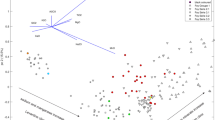The chemical and isotopic compositions of glass fragments found on the site of a former 18th – 19th glass plant in Kazan are studied. The finds are divided into three basic groups in terms of three types of glass from which they are fabricated: Ca–K, Ca–K–Na, and Ca–Na–K. The data on the chemical and isotopic composition show difference between the glasses in terms of recipe and raw material source. Comparison of the analytical and historical data suggested that each group of glasses corresponds to a definite time period of production. The composition of one group indicates the possibility that soda ash was added to the recipe.


Similar content being viewed by others
References
D. I. Mendeleev (ed.), Technical Encyclopedia, Glass Production, St. Petersburg, (1864), Vol. 4.
V. A. Galibin, Glass Composition as an Archaeological Source [in Russian], St. Petersburg (2001).
E. K. Stolyarova and K. I. Panchenko, “Glassware of the 17th century style façon de Venice from the Dmitrov Kremlin,” in: Archeology of Moscow: Proc. of Scientific Seminar [in Russian], Institute of Archeology of the Russian Academy of Sciences, Moscow (2014), Issue 10, pp. 206 – 216.
R. Khramchenkova, A. Sitdikov, and A. Kaisin, “Post-Medieval glass workshop from the excavation in the Kazan Kremlin,” in: Conference Proceeding SGEM 2016, Albena (2016), pp. 277 – 286.
R. B. Scott, A. J. Shortland, P. Degryse, et al., “In situ analysis of ancient glass: 17th century painted glass from Christ Church Cathedral, Oxford and Roman glass vessels,” Glass Technol.: Eur. J. Glass Sci. Technol., 53(2), 65 – 73 (2012).
M. Verita, “Italian window glass chemical composition from the Roman time to the 18th century, Verre et fenêtre de l’antiquité au XVIIIe Siècle,” in: Actes du Premier Colloque International de l’Association Verre et Histoire, Paris 13 – 15 Octobre 2005, published online 2011. URL: http://www.verre-histoire.org/colloques/verrefenetre/pages p. 203_01_verita.html.
D. Dungworth and C. Brain, “Late 17th century crystal glass: an analytical investigation,” J. Glass Studies, 51, 111 – 137 (2009).
L. Dussubieux, “Chemical investigation of some 17th-century French glass personal ornaments,” J. Glass Studies, 51, 95 – 110 (2009).
C. Belmonte and C. S. Salerno, “Mosaic glass made in Rome between the sixteenth and seventeenth centuries: Rome glassmakers for the Fabrica di San Pietro,” Journal Cultural Heritage, No. 9 (Sup. 1) (2008).
H. Willmot, “Post-Medieval Glass in England,” Council for British Archaeology Research Report, 132, 1500 – 1670 (2002).
D. Dungworth, “Innovations in the 17th-century glass industry: the introduction of kelp (seaweed) ash in Britain,” in: Actes du Deuxième Colloque International de L’association Verre & Histoire, Association Verre & Histoire, Paris (2011); URL: http://www.verrehistoire.org/colloques/innovations.
A. G. Sitdikov, Kh. M. Abdullin, R. Kh. Khramchenkova, and P. Y. Kaplan, “Kazan glass factory of XVIII – XIX centuries: history, archaeology, discoveries,” The Turkish Online Journal of Design, Art and Communication, 6, November Special Edition, 2869 – 2875 (2016).
N. F. Kalinin and M. G. Khudyakov, “Archaeological Exploration in the Republic of Tadzhikistan,” Krasnaya Tatariya, No. 207 (1929).
T. L. Mityushina, Supplier to the Court of His Imperial Majesty (from the History of the Glass Business of Merchants of Kosterevykh in Vladimir Province) [in Russian]; URL: http://www.mko.ru/rus/mitushina1.shtml.
D. Barskov and A. Kozhevnikov, Chronicle of the Development of the Misheron plant of Kosterevykh. The Origins of the Glass Industry in Vladimir Meshchere [in Russian], URL: http://www.shaturyane.ru/settlements-misheronsky-glassworks.php.
P. M. Lukyanov, History of Chemical Trades and Chemical Industry in Russia up to End of the 19th Century [in Russian], Izd. Akad. Nauk SSSR, Moscow – Leningrad (1948), Vol. 2.
R. Khramchenkova, P. Degryse, A. Sitdikov, and A. Kaisin, “Analytical studies of post-Medieval glass bottle marks from excavations at Kazan Kremlin (Russia),” J. Archaeolog. Sci.: Reports, 12C, 25 – 27 (2017); DOI: 10.1016/j.jasrep.2017.01.005.
This work was supported by the Republic Foundation for the Restoration of Monuments in the Republic of Tatarstan.
Author information
Authors and Affiliations
Corresponding author
Additional information
Translated from Steklo i Keramika, No. 5, pp. 38 – 42, May, 2017.
Rights and permissions
About this article
Cite this article
Khramchenkova, R.K., Degryze, P., Sitdikov, A.G. et al. Dynamics of Chemical Composition Variation of 18th – 19th Century Russian Glass. Glass Ceram 74, 180–184 (2017). https://doi.org/10.1007/s10717-017-9957-5
Published:
Issue Date:
DOI: https://doi.org/10.1007/s10717-017-9957-5




